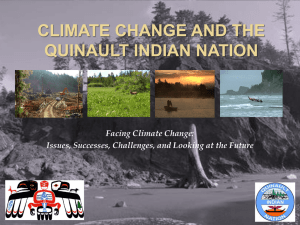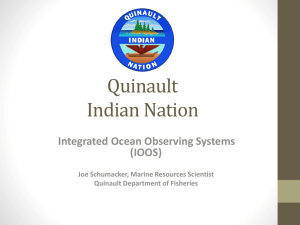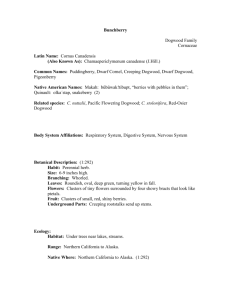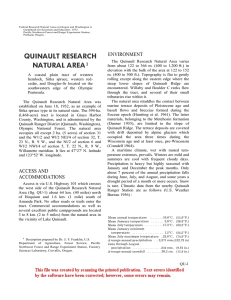161 Enclosure 3A - Project Summary Form QUINAULT INDIAN NATION
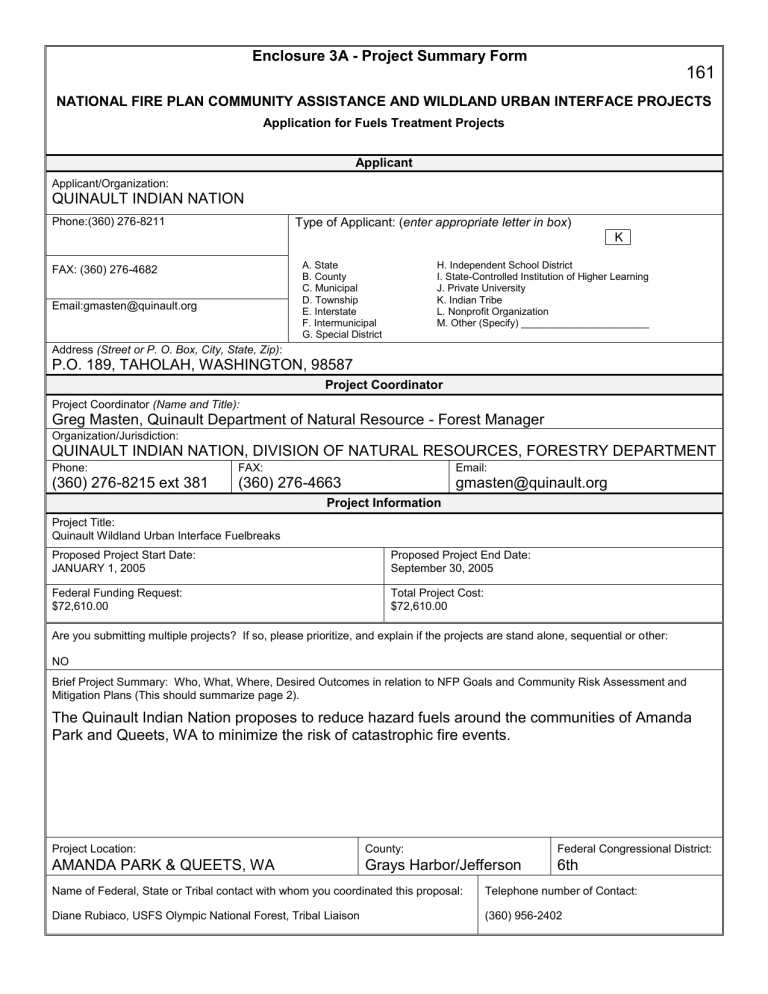
Enclosure 3A - Project Summary Form
161
NATIONAL FIRE PLAN COMMUNITY ASSISTANCE AND WILDLAND URBAN INTERFACE PROJECTS
Application for Fuels Treatment Projects
Applicant
Applicant/Organization:
QUINAULT INDIAN NATION
Phone:(360) 276-8211 Type of Applicant: ( enter appropriate letter in box )
K
FAX: (360) 276-4682
Email:gmasten@quinault.org
A. State
B. County
C. Municipal
D. Township
E. Interstate
F. Intermunicipal
G. Special District
Address (Street or P. O. Box, City, State, Zip) :
P.O. 189, TAHOLAH, WASHINGTON, 98587
Project Coordinator
H. Independent School District
I. State-Controlled Institution of Higher Learning
J. Private University
K. Indian Tribe
L. Nonprofit Organization
M. Other (Specify) _______________________
Project Coordinator (Name and Title):
Greg Masten, Quinault Department of Natural Resource - Forest Manager
Organization/Jurisdiction:
QUINAULT INDIAN NATION, DIVISION OF NATURAL RESOURCES, FORESTRY DEPARTMENT
Phone: FAX:
(360) 276-8215 ext 381 (360) 276-4663
Email: gmasten@quinault.org
Project Information
Project Title:
Quinault Wildland Urban Interface Fuelbreaks
Proposed Project Start Date:
JANUARY 1, 2005
Proposed Project End Date:
September 30, 2005
Federal Funding Request:
$72,610.00
Total Project Cost:
$72,610.00
Are you submitting multiple projects? If so, please prioritize, and explain if the projects are stand alone, sequential or other:
NO
Brief Project Summary: Who, What, Where, Desired Outcomes in relation to NFP Goals and Community Risk Assessment and
Mitigation Plans (This should summarize page 2).
The Quinault Indian Nation proposes to reduce hazard fuels around the communities of Amanda
Park and Queets, WA to minimize the risk of catastrophic fire events.
Project Location:
AMANDA PARK & QUEETS, WA
County:
Grays Harbor/Jefferson
Federal Congressional District:
6th
Name of Federal, State or Tribal contact with whom you coordinated this proposal: Telephone number of Contact:
Diane Rubiaco, USFS Olympic National Forest, Tribal Liaison (360) 956-2402
Enclosure 3A (Page 1 of 3) - Project Narrative Description
Applications for funding must include a narrative response that describes the proposal. Please do not submit responses longer than one page, single space, 12-pitch font.
Describe project including, but not limited to:
Address
project location (e.g., Watershed, neighboring community) these items as applicable:
anticipated outcomes community partners and their role(s)
project relationship to the community risk assessment and mitigation plan amount or extent of actions (acres, number of homes, etc.) project timeline and matching or contributed funds
proponent’s ability to complete project
For this project, explain the level of cooperation, coordination or strategic planning, through a “Local Coordination
Group.” If you haven’t worked with a local coordination group, why not?
Our project will create 100 feet of defensible space around the communities of Amanda Park and Queets located in northwest Washington. The project will include biomass removal of brush, shrubs, downed and dead woody material, small trees with a DBH of 6” or less, and tree limbs to six feet up trunks from residential surroundings. This will be accomplished by mechanical (power saw) thinning, hand piling, and pile burning. The anticipated outcome is to reduce the level of threat to life, property, and resources in the event of a wildland fire near these communities.
The Quinault Nation has no direct community partnerships at this time, but meets quarterly with the United
States Forest Service (USFS) - Olympic National Forest to coordinate on other activities. We have received positive support from the surrounding communities. Staff turnover has, at both the Quinault Nation and at the
USFS headquarters, prevented new contacts to be developed prior to the application deadline. The project will be in accordance with the Fire Management Plan Chapter 2, Section 2.1, Page 26 of the Quinault Indian
Reservation Forest Management Plan Oct.2002-Sep.2012. Specifically, the project will meet the goals of the
Fuels Management Program-Hazard Reduction Strategy, Item 2. “Identify and treat areas needing hazard reduction and /or site preparation resulting from timber harvesting, forest development activities, and climatic events.” Also, the Fire Management Constraints, as addressed on page 26, Item 2 of the Appropriate
Management Response Strategy will be “Protecting with all efforts wildland-urban interface communities.”
The area to be treated will be approximately 25 acres (affecting approximately 70 structures) around the community of Amanda Park and 20 acres (affecting approximately 55 structures) around the community of
Queets. The 45 acres to be treated will be completed on only Quinault Indian Nation owned lands. We anticipate that it will take us five months to complete this project. Work will begin with cutting and piling in
January, February, March, April, and May, and conclude with each pile being burned in October. All burning activities are coordinated with the Washington State Department of Natural Resources and are in accordance with the Quinault Smoke Management Plan. Currently, we have no matching funds available. With the use of
Quinault Fire Management staff our ability to complete this project is very likely. The Quinault Fire
Management staff will coordinate the project and be solely responsible for the successful completion of the project. It is our intention to use five (5) trained and able bodied fire crewmembers to complete laborintensive work at these sites.Where feasible and accessible the use of a Caterpillar 318CL excavator with a
Slashbuster XL 480S attachment, owned and operated by the Quinault Indian Nation, will be used to obtain target acres and reduce costs.
Queets and Amanda Park were chosen for fuels treatment due to their location in a remote part of the
Quinault Indian Reservation, with very high volume of traffic with the location of U.S. Hwy. 101 running adjacent to both communities. The risk and potential threat to those communities is extremely high, especially in a dry summer climate, due to climatic events (low precipitation), natural fire exclusion and fuel build up by
100% suppression policies for 100+ years, and increased encroachment into the area by humans.
Enclosure 3A (Page 2 of 3) - Project Evaluation Criteria
Applications for funding must include narrative responses that address the following three criteria. Be sure you address every one briefly, yet thoroughly. Limit your responses to the area provided .
1. Reducing Hazardous Fuels (50 points)
A.
Describe the community infrastructure that will be protected.
B.
Explain how the proposal reduces fire behavior in high hazard areas by describing the fuels to be disposed or removed, and the techniques and timing of the treatments.
C.
How will the proposed treatments be maintained in future years?
D.
How will you use multi-party monitoring to improve this and future projects?
Response:
A.
The communities of Amanda Park and Queets are rural in nature with primarily residential structure type homes and a limited number of small commercial and assembly structures.
B.
Fuels reduction that will occur by creating defensible space around the perimeter of both communities and will also include fuels reduction between structures and U.S.Hwy. 101, by greatly reducing the potential fire intensity and in direct proportion reducing the threat of extreme fire behavior. Primary vegetation to be removed is in the 1 hour to 10 hour time lag and includes berry vines, salal shrubs, vine maple, scotch broom, alder, spruce, fir, hemlock, and cedar with the predominant diameters ranging from ¼ to 1 ½ inches. Fuels will be disposed of by burning at times of low fire danger
(per National Fire Danger Rating System for appropriate fire weather/management zones 650 & 649 N. set by Washington
State Department of Natural Resources) under required burn policies and guidelines.
C.
The plan to maintain the proposed treatment areas will be scheduled as project work for seasonal fire engine crewmembers.
D.
We anticipate monitoring of the areas treated by our agency, the citizens in the communities affected, field staff from the following agencies; BIA Taholah Field Office, Olympic National Forest, Olympic National Park, Washington State
Department of Natural Resources, and local fire departments. We anticipate the implementation of a standard reporting system that all agencies will use to monitor, communicate, and record any needs to improve or further the treated areas or future fuels projects proposed by any of the cooperating agencies.
Enclosure 3A (Page 3 of 3) - Project Evaluation Criteria
2.
Increasing Local Capacity (25 points )
A.
How would the proposal improve or lead to the improvement of the local economy in terms of jobs and sustainable economic activity?
B.
How many jobs are expected to be created or retained and for how long? (Please distinguish between essentially year-round and seasonal jobs).
C.
What tools and skills will be gained or utilized as a result of this project?
D.
Will biomass be utilized; if so, in what manner and how much?
Response:
A.
Quinault Nation has experienced a high level of unemployment among tribal members; the project would employ five (5) trained fire crewmembers that normally would be unemployed between fire seasons.
B.
Five (5) seasonal jobs will be created for approximately 6 months. (January, February, March, April, May & September
15 th to October 15 th .)
C.
With the use of power saws our seasonal fire crewmembers will continue to advance their skill levels in using saws, with the eventual goal of all fuels crewmembers becoming certified and qualified class C sawyers. An increased awareness and understanding of the need for fire prevention among community members, that are not traditionally aware of the importance of it, will be created due to this project. The opportunity will arise for more machine operators of our
“slashbuster’s”, which may lead to permanent employment with the Quinault or surrounding businesses. The Quinault fire program owns several power saws that will be utilized to accomplish this project.
D.
Biomass use will be very limited. If biomass material is large enough for firewood, the wood will be given to the local elderly as a fuel source to warm their homes. Lack of economically feasible local market prevents further development of biomass utilization.
3.
Demonstrating Community and Intergovernmental Collaboration (25 Points)
A.
How will this project implement a community risk assessment and mitigation plan? Include name of plan, date it was prepared, and local contact to get a copy of the plan if requested.
B.
How has this treatment been coordinated with adjacent landowners and local/State/Tribal/Federal agencies?
C.
Identify the cooperators/partners involved in implementation of this project.
D.
Describe the extent of current local support for the project, including any cost-sharing agreements.
Response:
A.
This will help in the implementation of Quinault Indian Nation Fire Management Plan as outlined in the Quinault Indian
Reservation Forest Management Plan October 2002-September 2012, Chapter 2, Section 2.1, Page 26, Fire Management
Constraints, and Item 2. “Protecting with all efforts wildland-urban interface communities.” Contact Greg Masten, Forest
Manager for copy.
B.
Due to our state fire suppression agreement with the Washington State Department of Natural Resources, coordination is a must. In addition, our solid relationships with the local U.S. Forest Service and local National Park Service offices aid in the coordination for this project. All adjacent landowners will be notified of the project benefits and potential impacts to them (smoke).
C.
Quinault Indian Nation and the Washington State Department of Natural Resources.
D.
Local support for the proposed project has been good. As the level of awareness increases with the specific benefits to the community, the response has been resounding. There are no current cost sharing agreements.
Tasks
Mechanical Thinning (power saws)
Enclosure 3A - Project Work Form
Time Frame
January 2005 to May 2005
Responsible Party
Quinault Indian Nation,
Division of Natural Resources,
Forestry Department,
Fire/Fuels Management Office
Biomass Piling January 2005 to May 2005
Pile Burning
September 2005 to October 2005
(Weather dependent)
Quinault Indian Nation,
Division of Natural Resources,
Forestry Department,
Fire/Fuels Management Office
Quinault Indian Nation,
Division of Natural Resources,
Forestry Department,
Fire/Fuels Management Office
Enclosure 3D Project Budget
Cost Category
Description
Federal
Agency Applicant Partner 1 Partner 2
Personnel
101Temporary
Subtotal
Fringe Benefits
Subtotal
Travel
Subtotal
Equipment
Subtotal
Supplies
504 Operating
507 Fuel/Oil
Subtotal
Contractual
Subtotal
Other
842 Repair & Maint. Equip.
Subtotal
$55,258
$55,258
$11,152
$11,152
$1,000
$3,200
$4,200
In –Kind Donation
$2,000
$2,000
Total Costs $72,610
Project (Program) Income 1
(using deductive alternative)
1 Program income is the gross revenue generated by a grant or cooperative agreement supported activity during the life of the grant. Program income can be made by recipients from fees charged for conference or workshop attendance, from rental fees earned from renting out real property or equipment acquired with grant or cooperative agreement funds, or from the sale of commodities or items developed under the grant or cooperative agreement. The use of Program Income during the project period may require prior approval by the granting agency.
Total
